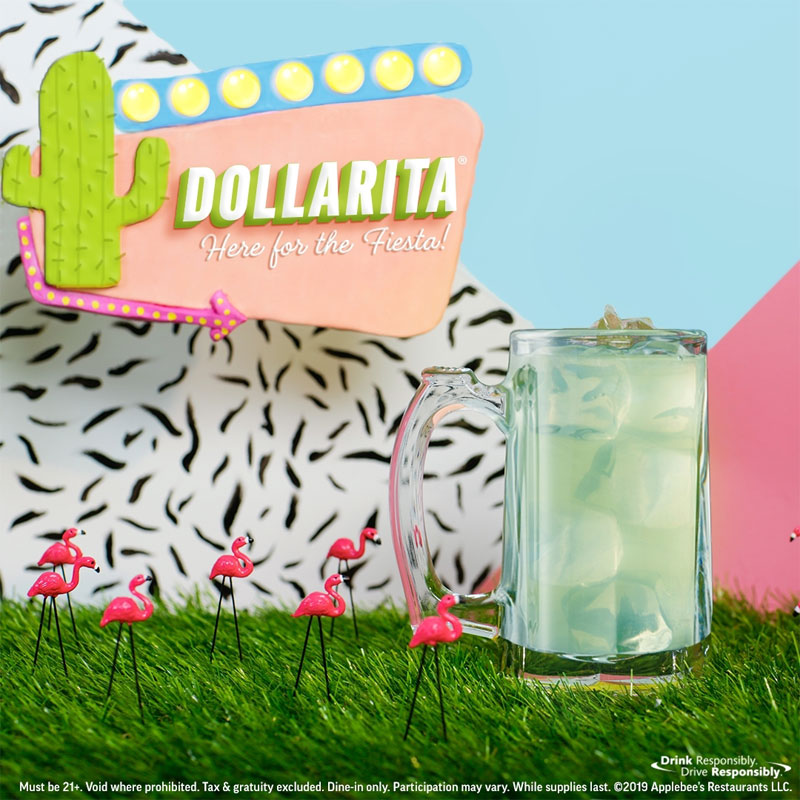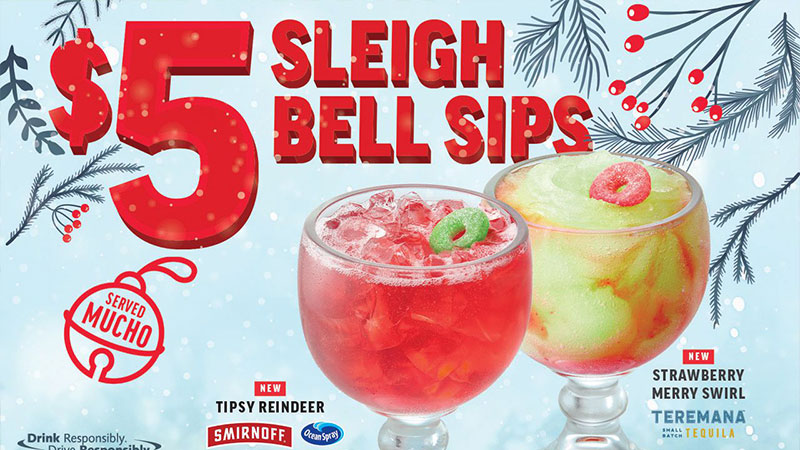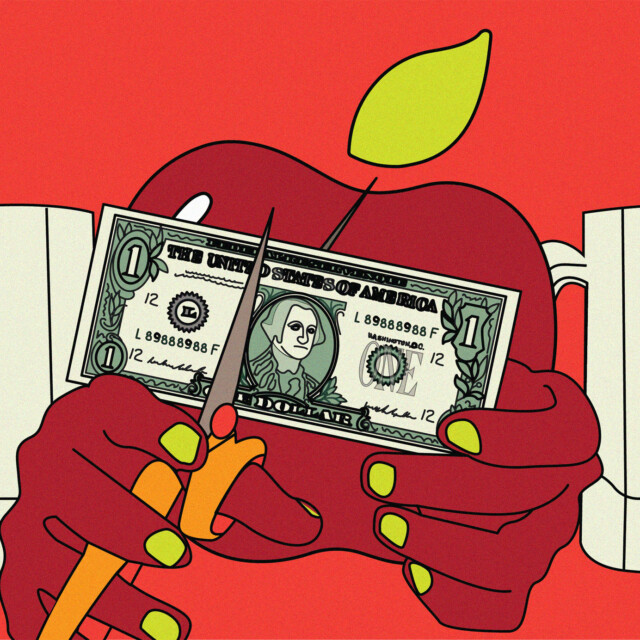It all started five years ago with a simple, lime green, $1 Margarita. The setting? Applebee’s Neighborhood Grill + Bars across the nation. Everyone had Taylor Swift’s “Reputation” on repeat and three Kardashian sisters were pregnant at the same time.
The country needed a budget pick-me-up.
That need was soon met by Applebee’s $1 drinks special, which would gain fame for its zany, bright, sweet concoctions, and for playing a key part in revitalizing the chain. Each month, the Applebee’s adult crowd could order a neon cocktail for less than the price of a bus fare. Offered for a mere three years, the campy, often tiki-inspired drinks still live on in customers’ memories and modern drinking lore.

“We focus on our food a lot, but ‘bar’ is in our name, and it is an integral part of what makes Applebee’s a great neighborhood destination,” Patrick Kirk, current vice president of beverage innovation at Applebee’s, said in a 2017 press release announcing the new offer. “Our $1 Margaritas in October give us a chance to show our guests a little love, giving them a totally unbeatable offer as a gesture of our sincere appreciation for their patronage.”
Cue: College students everywhere, rejoicing. (The $1 Drink of the Month program was especially aimed at customers in this 21 to 26 age range, Kirk told VinePair over email.)
Applebees $1 drinks made legendary nights in college 😂
— Mykal Walker (@MykalWalker3) May 15, 2022
While Kirk’s 2017 statement may have made it sound like Dollaritas were a gift for loyal customers, it’s likely that the chain’s intentions weren’t entirely selfless.
After closing numerous locations in 2017 amid the continued fallout from the 2008 recession, Applebee’s was struggling to bring customers in the door. In this situation, “loss leaders,” such as Dollaritas, are a common tactic to help revive sales, consumer behavior professor Ernest Baskin says. The term refers to a promotional item with little to no profit margin, designed to get customers in the door to spend on bigger-ticket items.
“Traditionally, alcohol is the high-margin item for restaurants. Restaurants who serve alcohol make a good portion of their money on alcohol, because they can make more margin on it than their food,” Baskin says. “The key is, there must be other things associated with your store that people are going to buy.”
In other words, Applebee’s bet on consumers sharing some appetizers over a round of the cheap drinks, and then hopefully moving on to other food items and drinks with better margins.
The tactic proved a success: Applebee’s marked a 5.5 percent jump in sales in 2018, according to Business Insider. As of 2019, alcohol accounted for 15 percent of sales at the chain and 55 million dollar drinks had been sold nationwide.
Many other cocktails followed that first fateful Dollarita. Patrons got L.I.T. with $1 Long Island Iced Teas in December 2017 and welcomed the Malibu “Dollarmama” the following February. Candy-spiked “Dollar Jollys” kept bar-goers merry and bright during the holiday months.
It was the best of times, it was… well, frankly, the best of times. Despite a 2017 video showing the drinks allegedly being batched in 5-gallon buckets (the incorrect method, according to a statement from Applebee’s), no one seemed to care. It’s not as if anyone expected a craft cocktail for just $1, as Twitter users pointed out.
I see there's a lot of debate about the #Dollarita. It's tequila for $1. Don't overthink it. 😉 pic.twitter.com/Y9kT97kaaT
— Jeff Barrett (@BarrettAll) April 5, 2018
A TikTok challenge appeared during the tail end of the drinks special’s life, with users posting increasingly tipsy video updates of themselves after rounds of $1 drinks, often sharing the low price of their final bill in the caption.
@yamesyboi22 Applebee’s $1 drink challenge (we took an Uber don’t worry) #fridaythe13th #applebeeschallenge #drink #imaboss #challenge #funny #fyp #foryou
Just three years after their launch, the Dollaritas were no more. As the Covid-19 pandemic hit North America, the chain served up transformed “Mucho Sips” to to-go customers for $5 after restaurants reopened in late 2020.
Why replace the beloved menu item? Loss leaders are a way for restaurants to bring hungry patrons in the door. But during the height of the pandemic, in-person restaurant visits simply weren’t happening. Consumer preferences changed with uncertain times as well.
“Coming out of the pandemic, as the landscape and guest demand had evolved, we recognized that guests were seeking higher-quality spirits in more premium cocktails, and this information inspired the launch of our Mucho Sips program,” Kirk says. “Applebee’s Mucho Sips are served in our signature Mucho glass, allowing for a larger volume than our $1 drinks did, and are made with top- shelf spirit brands such as Jameson, Patron, Grey Goose, Tito’s, [and] Captain Morgan, among others.”
Among those others is Teremana, which offers blanco, añejo, and reposado tequilas under the direction of celeb owner Dwayne Johnson. The spirits brand launched in 2021 as a premium “Tequila of the People.”

The inclusion of such spirit brands shifts the focus of the drinks special — not only are customers still receiving a relatively sweet deal, but they’re also sipping a celebrity’s premium spirit.
“Applebee’s might be trying to position themselves as more higher-end,” Baskin says. As Americans have also come to expect rising prices due to inflation and supply chain issues, he says it’s an opportune time for the chain to present a higher-priced offering to guests.
“Fancy like Applebee’s on a date night” could be the new outlook for Applebee’s sips. The brand reported a healthy bounce-back from Covid woes in March 2022, with a 6 percent increase in comp sales between 2019 and 2021, according to Forbes.
As long as Applebee’s tables are filled and sales are rolling in, Baskin says it’s unlikely the dollar promotion will return in the near future. Ultimately, it’s already served its purpose.
I would sell my soul for dollar drinks at Applebees again
— jackielantern 🎃 (@8bitJackie) April 18, 2022
“The dollar drink catapulted Applebee’s into pop culture, and forever redefined beverage marketing at casual-dining restaurants,” Kirk says.
Amen to that.
